Can you survive the Dead of Winter?

Ah, the joys of a beautiful Fall season.
The weather’s cooling off and the beautifully colored leaves are now falling from the trees.
We’re pulling blankets from the closet and getting our fireplace readied for cozy nights.
And along with the bulk hot chocolate purchases for those cozy nights, we’re also buying candy for Halloween trick-or-treaters.
Oh, and the zombie apocalypse just happened and now we have to hope we can survive the Dead of Winter!
At least that’s what’s just happened in the game we’re reviewing today.
If you’re looking for a fantastic game for Halloween, Dead of Winter is totally worth checking out.
The game got a lot of buzz when Plaid Hat Games first published it a couple years ago. But because we aren’t zombie fans, we brushed it aside.
However, when I heard from others that it’s not like typical zombie games, I was intrigued and continued to wonder about it ever since.
So earlier this year I got a copy in a SaltCon game trade and am so glad I did. Because Dead of Winter is a blast!

Dead of Winter
Dead of Winter is a cooperative board game where players are a group of survivors trying to last through the winter after a zombie apocalypse.
Like most cooperative board games, players are trying to complete a common objective. However, even though everyone is working together to complete a main objective, players also have their own secret objectives to complete. Only players who complete their secret objective will win.
Players also have to be careful because within the group may be a Betrayer working against the colony!
Will you be able to survive the Dead of Winter?

How to play Dead of Winter
Since there’s a lot going on in Dead of Winter, I’ll just give a short rundown of how the game is played so you have enough context when you get to our thoughts of the game.
(If you’d like to skip this part, click here to jump right to the 13 Reasons I Love Dead of Winter.)
Set Up
The first thing to do is get familiar with the various components since the first page of the rulebook lists 32 different items! The next 3 pages give detailed and helpful visual information about the items.
Of course, a number of those are similar in nature — such as the different Item Deck cards that are just placed in 6 different locations.
That being said, the set up is actually straightforward.
Set out the 6 locations on the table (Colony, Police Station, Grocery Store, School, Library, Hospital, Gas Station) and place the shuffled corresponding Item Card Decks on each indicated location.
Players then choose one of the 10 Main Objective cards or draw one randomly. Each card is double-sided so players can choose their preferred objective difficulty level. Then the board is set up as described in the objective.
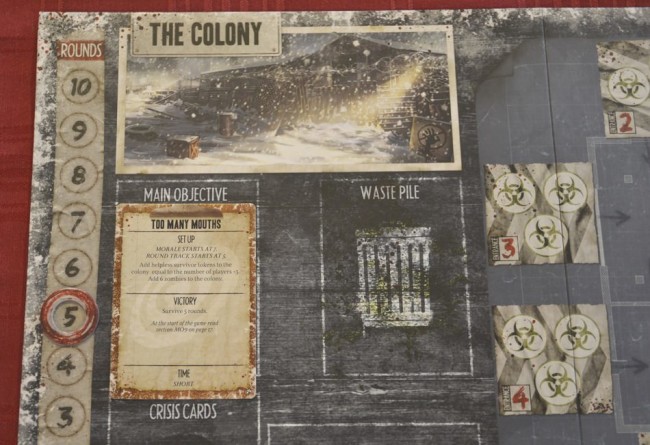
Players shuffle the deck of 24 secret objective cards and draw out 2 per player. Then they draw a random Betrayal Objective card and shuffle it in with the other secret objective cards. A card is dealt to each player and the others are put back in the box. In this manner, everyone receives a random secret objective card and there’s a possibility that someone may hold a Betrayal secret objective card. As you’d guess, players keep their secret objectives secret throughout the game.
A random Crisis card is then drawn and placed in the designated spot on the Colony board. Each round, a new Crisis will occur and players must address the current crisis by the end of the round or suffer the consequences.
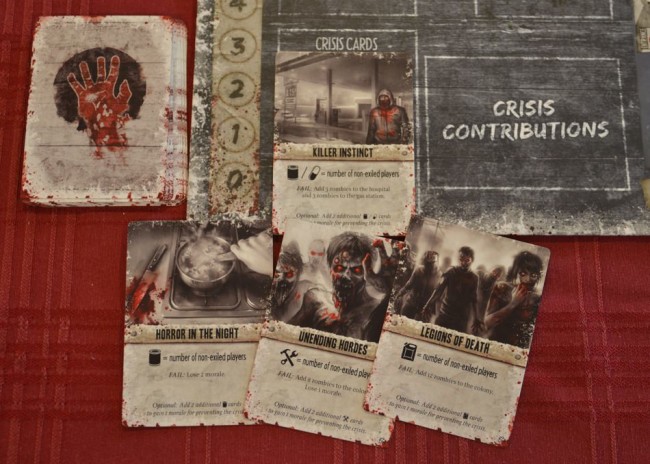
Each player gets their own player board and draws 4 survivor character cards. They then choose 2 out of the 4 and place one next to their player board where it says “Leader” and the other next to the spot where it says “Followers”. Thus each player begins with 2 people in their personal group. They then place the corresponding character standees in the Colony Occupants area.
Each player then receives 5 random Starter Item cards and it’s time to begin!

Player Turns
The Player Boards list everything you need to remember in regards to the phases of the game and options players have.
To begin a round, all players roll their dice simultaneously and place the results in their “Unused Action Dice” area of their player board. Players roll 1 die for each of their survivors (leader + followers) as well as 1 extra die. So on the first round, everyone will roll 3 dice.
At the beginning of a player’s turn, the person to their right draws a Crossroads card. That person reads the card to see what will trigger the event on the card. If that situation occurs during the player’s turn, then the person who drew the Crossroads card reads it out loud. The active player must choose one of the outcomes on the card to take effect. If the card doesn’t trigger, it’s placed at the bottom of the Crossroads deck at the end of the active player’s turn.
A player can take as many actions as they can or want on their turn. Some actions require the use of an action die and some do not.
The actions that require an action die are attacking, searching, putting up barricades, cleaning the waste pile, or attracting zombies.
For example, to attack or search the result on the die must be equal or higher than the values listed on the character card.
The actions that don’t require a die are moving a survivor, playing cards, contributing cards to the crisis, spending food tokens, requesting cards from others, handing off equipment, or voting to exile other players.
Yep, you can vote to exile a player if you think they may be a betrayer.

The vote is simply done by showing thumbs up or thumbs down. The majority wins and ties are broken by the first player.
If a player is Exiled, they draw a new secret objective from the Exiled Objectives deck. They can’t put any of their survivors in the Colony location or add cards to a Crisis. There are a few more rules for exiled players, but that gives you a good idea of their limits.
Once a player has taken all their actions, it goes to the next player on their left.
Rolling for Exposure
Before telling what happens in the next phase I have to tell you about Exposure – because it’s a dreaded die roll that happens frequently.
Any time a survivor moves locations or kills a zombie, they must roll the red Exposure die.
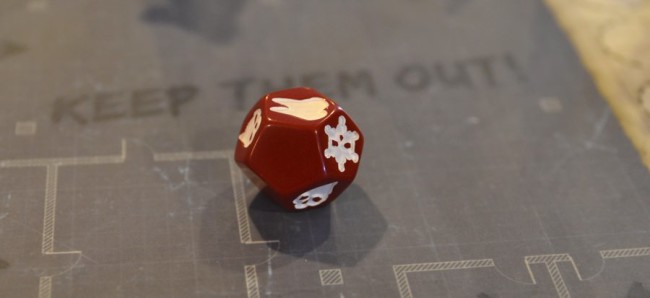
The possible results are that nothing happens, the survivor receives a Wound, the survivor receives Frostbite (which gives a Wound every subsequent turn), or the survivor is Bitten.
When a survivor is Bitten, he/she is killed and the bite effect spreads. It spreads to the survivor with the lowest influence in that shared location. Each time a bite spreads, the player of that survivor must chose to either kill that survivor to stop the effect from spreading immediately or roll the exposure die. On a blank, the spread stops and the survivor is safe. On any other result, the survivor it spread to is killed and it keeps spreading.
Whenever a survivor is killed for any reason, the colony loses 1 Morale.
So you can see why rolling the Exposure die is so dreaded.
It’s also adds so much fun to the game because everyone’s invested in the outcome of the roll.
It also means that characters or items that let you skip rolling the Exposure die are so helpful to have.
Colony Phase
Once all players have taken a turn, the round ends and the Colony Phase occurs in this order:
Pay Food: Survivors in the Colony location must be fed (survivors in other locations are scavenging for their food). Each food token in the Food Supply will feed 2 survivors (including helpless survivors). If there aren’t enough food tokens to feed everyone, none are used. Instead a Starvation token is added to the Food Supply. For each Starvation token in the Food Supply, 1 Morale is lost.
Check Waste: For every 10 cards in the Waste pile, 1 Morale is lost.
Resolve Crisis: The start player shuffles the cards in the Crisis Contributions pile and then reveals them one at a time. Each card with a matching symbol on the Crisis card adds 1 point. Each card that doesn’t match subtracts 1 point. If the total value of points equals or exceeds the required amount on the Crisis card, the crisis is prevented. If the value of points is double the required amount, 1 Morale is also gained. If the final point value is lower, then the crisis result is immediately applied.
Add Zombies: Add 1 zombie to the Colony for every 2 survivors present there. Add 1 zombie to each non-colony location for each survivor there. For each Noise icon at a location, an action die is rolled (one at a time). Each roll of 3 or lower adds another zombie. If there are no more spaces to add zombies, the survivor at that location with the lowest influence value dies.

Check Main Objective: If the goal on the Main Objective card has been achieved, then the game ends immediately.
Move Round Tracker: The round tracker is moved down 1 space. If it’s moved to zero, the game ends immediately.
Pass First Player Token: The First Player token is passed one player to the right and a new round begins.
Game End
There are 3 ways the game may end.
Either the Morale or the Round track markers hit zero or the Main Objective is achieved.
Once this occurs, players reveal their Secret Objectives and determine who, if anyone, wins the game.
Even if the main objective is completed, there may not be a winning player because in order to win, players have to complete their personal objectives.
All players who complete all the criteria listed on their secret objective card win.
13 Reasons why I love playing Dead of Winter
1. Immersed in the Game
As you can see, there’s plenty going on in Dead of Winter. But once players get started, it’s easy to get immersed in the experience and lose track of time.
I was naturally curious about Dead of Winter when it first came out because I really enjoy playing cooperative board games. But since I’m not a fan of zombie-themed anything, I was turned off by it.
Yet, I’d hear that it’s a zombie game that doesn’t really feel like a zombie game. So I figured I’d give it a try. Come to find out, I’ve had a blast.
It’s not that I’ve become a zombie fan at all. I’m still turned off by zombie movies, TV shows, books and games.
Dead of Winter just feels different.

2. Variety of Objectives
With 20 different Main Objectives, there’s tons of replay value in Dead of Winter. Players can either choose one they want or select them randomly.
The Main Objective cards even indicate the length of the scenario at the bottom of the card – Short, Medium, or Long.
The objectives all drive the game in unique ways. In some cases you may need to survive a certain number of rounds. While in others you may need to collect different items or kill a certain number of zombies.
In addition, each objective lists a different way for setting up the game. So every time you play, you’ll start out differently and try to accomplish different things.

3. Personal Secret Objectives and Potential Betrayer
So much of the game experience revolves around secret objectives. Not knowing what other players are trying to do creates a fair amount of tension.
It’s most likely they’re trying to complete the main objective just like you. However, one of them could be a Betrayer. You just don’t know!

Since some secret objectives have players hoarding cards, they may look suspicious. On the other hand they may just be doing it to complete their secret objective and still be on your side.
Likewise, if your secret objective is to collect Food cards, you may look quite suspicious when you don’t use those cards to help feed the survivors in the colony.
This secretive aspect in a cooperative game is very cool.
Some cooperative games get a bad rap for having an “alpha gamer” problem – in that one person takes control and tells everyone else what to do. But this doesn’t occur in Dead of Winter because of the secret objectives and this dice rolling and variety of options.

4. Crisis Contributions
Adding to the secretive aspect of the game are the contributions to the Crisis each round.
Since players have to contribute item cards facedown toward the crisis, no one really knows what they’re putting in the mix. Of course they say they added the right items, but can you be sure?
And as the game progresses, the amount of cards of the needed items to contribute may go down. So the tension increases as players debate who can or will contribute for the round.
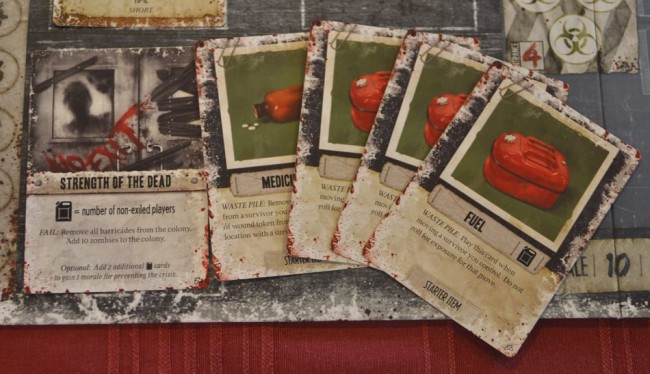
5. Rolling Dice Simultaneously
Even though players take turns throughout the game, at the start of a round everyone rolls their dice at once. This is great for a couple reasons.
First, it allows players to plan out their potential actions ahead of time.
Second, it lets players discuss how they can work together beforehand. For example, based on their dice roll perhaps the 3rd player’s best options are to search a certain area. So the other players could focus their actions on different activities such as building barricades or contributing to the crisis.
Even when it’s not your turn, you’re engaged with what’s happening to the rest of the survivors.

6. Crossroads Cards
The huge deck of Crossroads cards are awesome!
At the start of every turn, a Crossroads card is looked at by an adjacent player to see what the trigger conditions are. The event may trigger at the start of the player’s turn or during the middle of their turn.
For example, if they move to a certain location or take a certain action during their turn the event on the card may be triggered. But the active player won’t know until it happens.
Sometimes nothing is triggered because the conditions aren’t met.
But many times they are. And when that happens everyone gets excited.

While the active player is the one who must make the choice, everyone else will definitely chime in.
These cards add a lot of flavor and give the game its story-like flare.
Another thing we like about these cards is that some of them have an icon that indicates mature themes – so they can easily be removed from the game.
Yep, we tossed those out.

7. Searching
I love that each locations has their own unique deck of Item cards.
Rather than just having a large deck of cards that get randomly dispersed to the different locations, players now have reasons for going to certain locations.
If they were all dispersed randomly, it wouldn’t make a difference what locations survivors went to for rummaging. If one area is getting overrun with zombies, players could simply go to another location and the probability of what they find would be the same.
But in Dead of Winter, the locations matter.
Items have different probabilities of appearing at different locations. The types are listed as icons the top of the location cards. The icons to the left are more likely than those on the right.
For example, survivors will find more food at the Grocery Store and more medicine at the Hospital.
So if the Grocery Store has a bunch of zombies and you’re in need of food, that’s just too bad. A brave survivor will have to go for it.

8. Finding Survivors
The other fun thing about Searching is that you’ll also find lots of other helpful things along the way – including other survivors!
In addition to finding items to equip to your survivors, you may also find other survivors that will then become your followers. This in turn means you get more dice to roll and more actions on your turns.
Off course, it also means you’ve got more chances of losing one of your survivors…

9. No Player Elimination
Even though your survivors may die, you’re never out of the game.
If your leader dies, then one of your followers becomes your new leader. If your last survivor dies, the player removes all cards in their hand from the game and draws a new survivor card, making that survivor their leader.
Our first time playing the game, on one player’s first turn, he sent his first survivor to a new location. When he rolled the Exposure die, it was a Bite result and that survivor died. He then sent his remaining survivor to another location. Once again the Exposure die roll ended up as a Bite! And just like that both of his survivors were gone and we were down 2 Morale.
It was a rough start to the game being down on Morale so quickly, but he wasn’t eliminated from the game. We all felt the pressure and dug into the game even more. Very cool.
10. Survivor Abilities
Many modern board games provide special abilities to game characters – especially cooperative board games. So this really isn’t anything new.
But in Dead of Winter, these abilities are so crucial. And it’s hard to say which abilities we like most.
Obviously the abilities that don’t require survivors to roll the exposure die are pretty cool. But so are the abilities that allow people more efficient searching.
One of the things we like most about this is that players get to choose their starting survivors. Rather than just being given one randomly, all players take 4 survivor cards and choose 2 to start with.
It’s a fun choice right from the start.

11. Player Boards and other Components
The Player Boards are very handy in Dead of Winter.
Not only do they provide an area for a player’s survivors and dice, but they also provide a fantastic reference for remembering the order things occur each round as well as possible player actions.
It may sound simple, but even having a spot for Unspent Dice and Spent Dice is helpful on a players turn. Because sometimes, many things can happen after taking a dice action and it’s nice to remember which dice results are left to work with.
We also like the quality of all the components. For example, the two markers that track the Round and Morale are rings rather than cubes or discs. It may sound too simple, but being able to see the number of the space the marker is on is very nice. Having the markers ring shaped is slick.
We also love that all the female characters in the game are modestly dressed. Too many themed board games disrespect women characters with immodest attire. I guess that’s one good reason for the setting of the game to be winter – it makes sense they’re all bundled up.

12. Exposure Die
We know a lot of people can’t stand the Exposure Die.
We’ve heard it said that this is the most hated die in all board gaming.
But we get a kick out of it!
Even in the situation we mentioned above where a player’s two survivors were lost in in the first round through successive Exposure Die rolls we had a great time.
I don’t know what the exact probability of that happening is, but it’s pretty slim.
We mostly love the Exposure Die because of how much tension it can bring to the game. We know we need to move to another location or to kill one more zombie. But doing so will require the die roll – do we go for it anyway? We’re all on the edge of our seat with every roll.
And that makes for a fun game.
13. Game Variants
Like many modern board games, players can also try a few different game variations in Dead of Winter. One of the suggested variations included in the rulebook is the Betrayer Variant. In this variant, when creating the Secret Objective deck to start the game players only add in 1 non-betrayer secret objective card for each player rather than the standard 2 cards. This dramatically increases the likelihood that a Betrayer will be in their midst.
There’s plenty of replay value in Dead of Winter even without the suggested variants, but it’s great to have them in there.
Can the whole family enjoy Dead of Winter?
I’m sure you’ve picked up by now that Dead of Winter is not well suited for families wanting to play with young kids.
Dead of Winter is best suited for teenagers and above.
Like me when I first heard about the game, the zombie theme will turn off a lot of people. In addition, the artwork and red splotches will also turn off a number of people. To help you determine the suitability for your family or friends, we’ve made sure to provide a representative sample of the imagery in the game in our photos.
On the other hand, there’s a reason why so many zombie shows and games are being made – because there are a lot of people who love the theme. They’ll love the chance to hold out against a zombie attack.
At the same time, the theme and artwork aren’t the only things to consider in regards to who in your family may like Dead of Winter.
Even outside the zombie theme, the game is a bit advanced and can take a long time to play.
There are plenty of things going on within the game to keep track of. And with all the decisions to be made, much time passes between player turns.
Yet because it’s a cooperative game, players will have plenty to discuss even when it isn’t their turn.
In our family, mom isn’t interested in playing Dead of Winter for both of those reasons – zombie theme and length of play.

How does Dead of Winter score on our “Let’s Play Again” game meter?
 Outside of mom, Dead of Winter scores high on our “let’s play again” game meter.
Outside of mom, Dead of Winter scores high on our “let’s play again” game meter.
Due to the length it isn’t a game we play back to back. But it is a game that we look forward to playing when we’re after a very engaging cooperative game.
And with Halloween this month, it’s hitting the table a few times for sure.
Many of the reasons I describe above (such as the variety of objectives, crossroads cards, and plenty of different survivors) contribute to it being a great game for playing multiple times.
TIP:

If you’re going to get a copy of Dead of Winter, we highly recommend getting a good game insert for the components.
Insert Here sent us a foam core game insert for Dead of Winter that’s great.
Before that, we used bags to contain all the different components which were then just tossed in the box however they could fit.
The game insert from Insert Here provides a nicely organized way to store the components. And even though we don’t use card sleeves for the cards, the space provided is sufficient if you choose to sleeve your cards.
The insert trays for the dice and tokens are great because we can leave the tokens in their tray during the game. It saves space on the game table and makes it easier to set up and put away the game as well.
Check out the more than 150 game inserts from Insert Here.
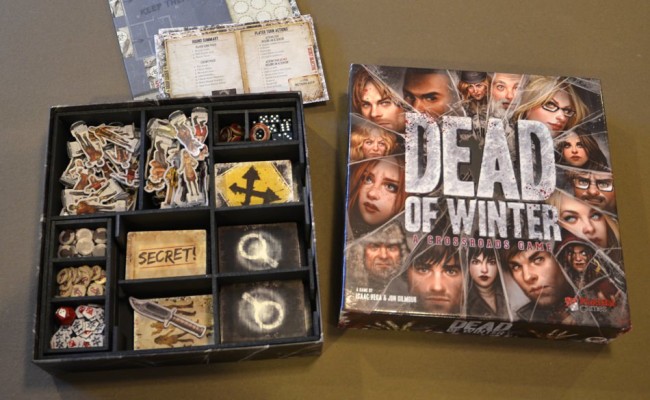
Our next review is another game that’s also great to play around Halloween. Stay tuned.



My wife was pretty hesitant to play Dead of Winter at first because she doesn’t like zombies, now it’s one of her favorite games. She may or may not be getting the Long Night for her birthday coming up. (she may or may not be reading this)